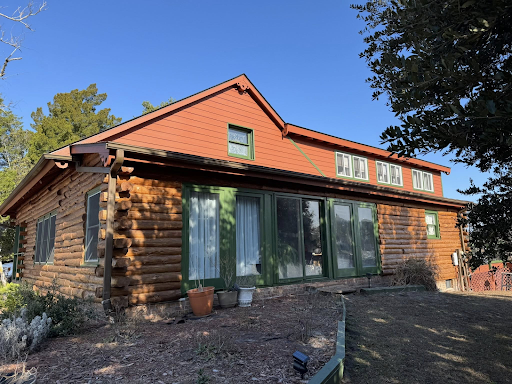Log homes have a charm that’s hard to beat. The rustic feel, the warm wood, the scent of pine or cedar—there’s nothing like it. But there’s a downside that comes with living in a log home: rot. And I’m not talking about a tiny spot you can ignore. I’m talking about serious, damaging log rot that eats into your walls, weakens your structure, and can turn a dream cabin into a nightmare. If you’re here, you probably want to know how to handle it without losing your mind. Let’s dive in.
Repairing rotted logs log home owners often face is tricky. It’s not like patching a wall in a regular house. Logs are structural, and once the rot sets in, it can spread fast. Ignoring it isn’t an option. You need to understand why it happens, how to spot it, and what you can realistically do to fix it.
What Causes Log Rot?
Log rot isn’t some mysterious force. It’s just wood breaking down because of water, moisture, and neglect. Most rot starts because of water sitting on or in the wood. It could be rain splashing up from the ground, poor roof overhangs, leaky gutters, or just a damp corner of your porch. Logs love to breathe, but they hate sitting wet for long periods.
Fungi are the culprits here. They move in when the wood is wet, feeding on the cellulose and lignin inside. Over time, the log softens, starts to crumble, and if left unchecked, the structural integrity fails. You’ll see discoloration, soft spots, and maybe even a musty smell. Sometimes the wood looks fine on the outside but is rotten inside—tricky and sneaky.
Sun exposure also plays a role, believe it or not. Logs that dry out too slowly after getting wet are more vulnerable. And insects? Yep, termites and carpenter ants can accelerate the damage once the wood is weakened by moisture.
Signs Your Logs Are Rotting
Spotting rot early saves headaches and money. There are a few telltale signs to watch for:
- Soft or spongy wood: Push a screwdriver into the log. If it sinks easily, that’s trouble.
- Cracking and splitting: Small cracks are normal, but deep, dark cracks often hide rot.
- Discoloration: Dark streaks or patches can indicate fungal activity.
- Odor: That damp, earthy smell isn’t just mold—it’s wood breaking down.
Honestly, if you see one or two of these signs, it’s time to act. Don’t wait until the logs are falling apart.
How to Repair Rotted Logs
Now we get to the messy part. Repairing rotted logs log home owners deal with isn’t glamorous, but it’s doable. The method depends on how bad the rot is.
For minor rot, you can often dig it out with a chisel or a grinder, then fill the cavity with an epoxy or wood filler. Make sure the area is dry first. Epoxy penetrates the wood, hardens, and restores strength. It’s a little messy, a little sticky, but effective.
For more extensive rot, you may need to cut out the damaged section entirely. This is where things get technical—you might need to scarf in a new log section. It’s not beginner-level work, so don’t be shy about calling professionals. A quick search for log cabin contractors near me can save you a lot of trial-and-error frustration. These guys know how to match wood, ensure structural integrity, and seal it against future moisture.
Sealants and stains are your friends here. After repairs, treat the logs with high-quality wood preservative and stain. It won’t make them immune to rot, but it gives a solid line of defense against moisture and sun damage.
Preventing Future Log Rot
Fixing rot is one thing; preventing it is another. Regular maintenance is key.
- Check your gutters: Make sure water isn’t dumping onto your logs.
- Maintain roof overhangs: Logs need protection from direct rainfall.
- Seal the logs: Periodic staining or sealing keeps moisture out.
- Inspect often: Walk around your cabin a few times a year, checking corners, joints, and areas near the ground.
Even small changes in drainage can make a huge difference. Water is the enemy, plain and simple.
When to Call in the Pros
Some log rot repairs are DIY-friendly. Others? Not so much. If you’re facing rot on structural logs, corners, or support beams, don’t gamble. Call experienced log home contractors. Yes, it costs money, but it’s worth it to avoid a bigger disaster down the line.
Professional contractors bring the right tools, techniques, and knowledge. They can also spot hidden rot that you might miss. And honestly, sometimes the repair looks better than the original wood—so there’s that.
Conclusion
Log rot isn’t something you can ignore. It’s sneaky, destructive, and if left unchecked, it can ruin your log home. But the good news? It’s fixable. By understanding what causes it, knowing the signs, and acting quickly—either with DIY fixes for minor damage or professional help for bigger problems—you can keep your cabin solid for decades. Remember: moisture is the enemy, fungi are relentless, and preventive maintenance is cheaper than repairs. And just like you’d pay attention to the interior design of log cabins, you should give the same care to the exterior. If you’re serious about protecting your investment, don’t skip inspections, don’t delay repairs, and don’t underestimate the value of expert advice. Repairing rotted logs log home owners face is challenging, but with attention, patience, and a bit of elbow grease (or the right contractor), you can keep your cabin looking and feeling like home.





Comments